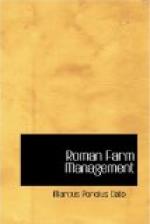“Finally, by the third step, man descended from the pastoral age to that of agriculture. In this there have persisted many relics of the two preceding ages, which, long remaining in their original state, are found even in our day: for in many places may yet be seen some kinds of our domestic cattle still in their wild state, such as the large flocks of wild sheep in Phrygia, and in Samothrace a species of wild goats like those which are called “big horns” (platycerotes) and abound in Italy on the mountains of Fiscellum and Tetrica. Every body knows that there are wild swine, unless you maintain that the wild boar is not a true member of the swine family.
“There are still many cattle running at large in Dardania, Medica and Thrace, while there are wild asses in Phrygia and Lycaonia, and wild horses in certain regions of hither Spain.
“I have now told you of the origin of the industry of feeding cattle. As to its importance, I have this to say:
“The most important persons of antiquity were all keepers of live stock, as both the Greek and Latin languages reveal, as well as the earliest poets, who describe their heroes some as [Greek: polyarnos] (rich in lambs), some as [Greek: polymaelos] (rich in sheep), and others as [Greek: polyboutaes] (rich in herds), and tell of flocks which on account of their value were said to have golden fleeces, like that of Atreus in Argos which he complained that Thyestes stole away from him: or that ram which Aeetes sacrificed at Colchis, whose fleece was the quest of those princes known as the Argonauts: or again like those so called golden apples (mala) of the Hesperides that Hercules brought back from Africa into Greece, which were, according to the ancient tradition, in fact goats and sheep which the Greeks, from the sound of their voice, called [Greek: maela]: indeed, much in the same way our country people, using a different letter (since the bleat of a sheep seems to make more of the sound of bee than of me) say that sheep “be-alare,” whence by the elision of a letter as often happens, is derived the word belare (or balare), to bleat.
“If cattle had not been held in the highest esteem among the ancients the astrologers would not have called the signs of the zodiac by their names in describing the heavens: and they not only did not hesitate to place them there but many even begin their enumeration of the twelve signs with these animal names, thus giving Aries and Taurus precedence over Apollo and Hercules, whose signs, very gods as they are, are subordinated under the name of Gemini: nor did they deem that a sixth of these twelve signs was a sufficient proportion for the names of cattle, but they must even add Capricornus and make it a quarter. Furthermore, in naming the constellations they selected other names of cattle, as the goat, the kid, and the dog. And in like manner have not certain parts both of the sea and of the land taken their names from




